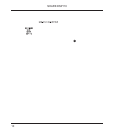
8
SHARK DSP110
9
The LOW CUT button lets you enter the high pass filters cut-off frequency
(20 to 150 Hz). When set to OFF the filter is inoperative. The control and Hz
LEDs light up while you are entering a value. Use the UP/DOWN buttons to
edit. Pressing the LOW CUT button for a longer time (please wait, until all
five parameter LEDs light up) enables the keypad lock feature which prevents
inadvertent editing of parameters and settings. When the keypad lock is enabled,
the LOW CUT keys control LED starts flashing.
10
Use the GATE button to adjust the threshold of the internal Noise Gate (-96 dB
through -44 dB). When set to OFF, the Noise Gate is inoperative. The control
LED of the GATE button lights up while you are entering a value. Pressing the
GATE button for a longer time (please wait, until all five parameter LEDs light
up) enables the GATE LEARN function, which automatically sets the Noise
Gate threshold by analyzing the program material and adjusting the value
accordingly (value detected plus 2 dB). In GATE LEARN mode, the GATE keys
control LED starts flashing. As long as the LED flashes, the detected value is
read on the display, when the LED stops flashing, the value is raised by +2 dB.
11
The COMPRESSOR button gives you access to two parameters that let you
adapt the DSP110s Compressor function to the program material. Press the
button once to adjust the DENSITY parameter, which controls the compression
density from 0 (no processing) to 100 (maximum compression). Press the
COMPRESSOR button a second time to adjust the SPEED parameter which
controls the Compressors attack and release times from 10 to 1000 msec. The
msec LED lights up as soon as you select the SPEED parameter.
12
The FILTER key allows you to set the feedback detection sensitivity within a
range from 1 (no sensitivity) through 100 (full sensitivity). The default value is
50. The control LED lights up during data entry. Briefly press the FILTER key a
second time to edit the maximum attenuation of the FB-D filter (from -3 dB
through -48 dB in steps of 3). Pressing the FILTER key longer (please wait, until
all five parameter LEDs light up) activates the FILTER LEARN function, which
automatically searches for feedback frequencies and assigns free filters to the
frequencies found. Now you can enter the number of filters (standard: 9) to be
used for permanent feedback suppression. Although the remaining filters are
also used to eliminate feedback frequencies, they are released once new
feedback occurs. Pressing the FILTER key once again activates the FILTER
LEARN function.
1. INTRODUCTION


















